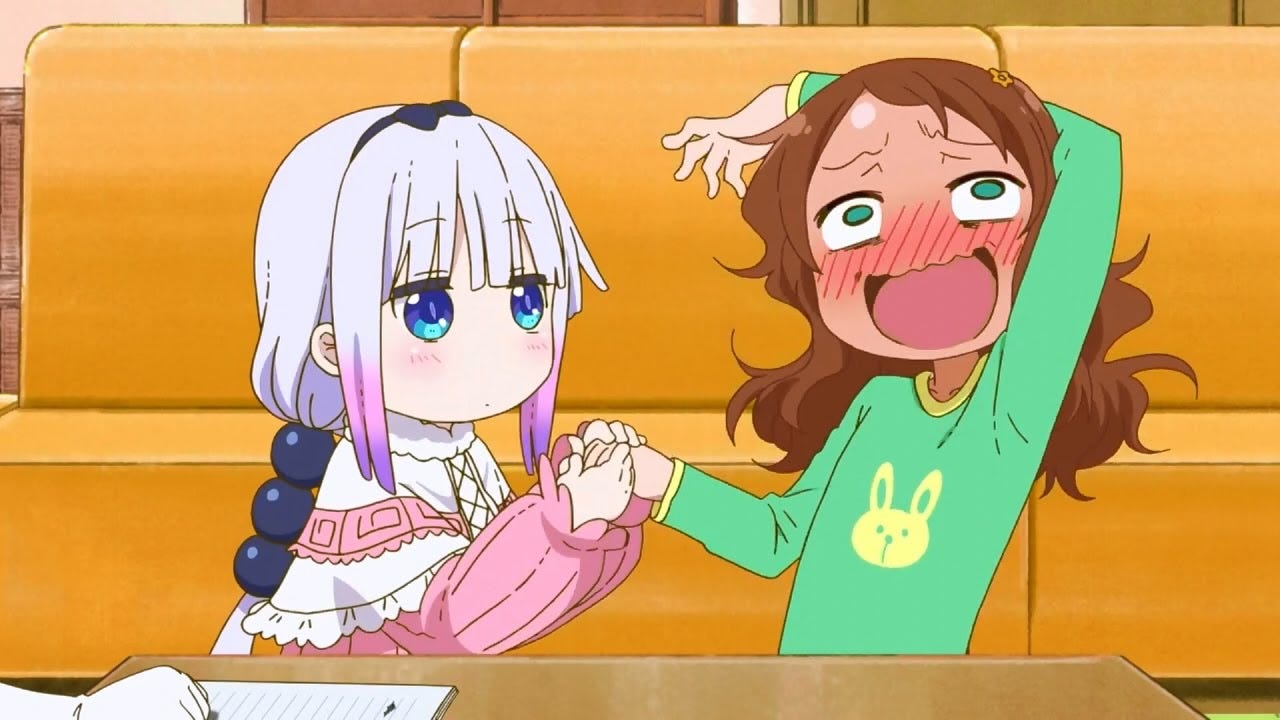How to Do Character Overlays in Old Anime
How to Do Character Overlays in Old Anime
And then, What Makes, or Doesn't Brand, a Character a Loli?

With all the recent "thicc" comments about Kanna, from Kobayashi-san Chi no Maid Dragon, I thought I'd become into that potentially-police-attracting realm of loli characters. Specifically, what makes a character a loli?
The term loli is curt for lolicon, which itself is curt for lolita circuitous, describing someone who is interested in lolitas. Lolita, as a term, came to Nippon via the 1955 novel Lolita about a middle-aged human who is obsessed and sexually involved with a 12-year-erstwhile girl. It gained traction in two different manners in the 1970'due south: equally a way argument and equally a descriptor for erotic doujinshi involving underage girls.
Given the etymology, information technology makes sense to get-go with lolicon for determining what exactly makes a character a loli. Lolicon very specifically implies sexual feelings toward an underage female person grapheme. A person who watches shows nigh children because they wish that they had children of their own to nurture and raise is clearly not a lolicon. Neither is someone who watches a prove well-nigh children considering they're bored, their friend is watching it, or it happens to come up on betwixt two other shows that they scout. Information technology has to be sexual. Lolicon doesn't exactly equal pedophile, because it applies primarily to characters, not real people, but it'due south an absolutely blurry line for some.

If we start with lolita as our etymological term instead, we arrive at a similar place. Lolita, in terms of its mutual utilize, refers to an underaged, female, sexual character. Given both of these, you might assume that a loli is then any female character who is underage and presented in a sexual manner.

Yet, anime has managed to ruin this dainty, simple caption with characters like Oshino Shinobu. In her child form, one would exist hard-pressed to deny her as a loli character, simply her actual age is over 500.
Besides these much-older-than-they-appear characters is Megumin in KonoSuba, who tries to deny her loli-ness to Kazuma by insisting that, every bit a 14-twelvemonth-old, she has just recently graduated from loli condition. Kazuma denies her exclamation, telling her that looking like a loli makes her a loli — this probably makes more than sense in the web novel, which has her as 17 or so instead, only anyhow… On the other hand, there are characters like Yoko, from Gurren Lagann, who are underage only don't look it. She's not a loli, despite her age and definitely sexual presentation.
So, possibly, it's any character who appears to be underage and is depicted in a sexual manner.

Enter Masamune's mother in Masamune-kun no Revenge — or any other adult female person who isn't particularly displayed in whatever sexual mode, only looks similar a child. She's described as a loli graphic symbol, but she'south never given any sexual characteristics across beingness of an historic period to accept had Masamune. This adds a non-sexual side to lolis.

However, nosotros can't simply motility on to any graphic symbol who appears to be underage. In Amaama to Inazuma, Tsumugi is almost certainly not a loli, but she both is and appears to exist underage. The main reason she's generally not considered a loli is because she'southward not presented in an even slightly sexual fashion (fifty-fifty when she, herself, is attempting to do so), reintroducing sexuality into the definition.
S0, combining the above, what we can conclude is this: a loli is a graphic symbol who appears to be underage and, if they actually are underage, is depicted in a sexual manner.
Back to Kanna.

Kobayashi-san Chi no Maid Dragon has a child dragon — so, regardless of historic period in human years, definitely underage — named Kanna, who takes the grade of a human kid and appears to be underage. Given my previous definition, this ways that, to be a loli, she has to exist depicted in a sexual manner. This is where things become subjective.

At that place is some other girl her (apparent) historic period, Saikawa, who is attracted to Kanna. As a child, she probably doesn't have a firm idea of what exactly she'southward wanting of her, but she often displays ahegao-type expressions because of Kanna. Without going besides far into it, on an older character, this would be a definitely sexual expression. This is what makes her grapheme ambiguous when it comes to her loli-ness. Kanna doesn't exercise much that is inherently sexual, but she and Saikawa do go into situations that, between older characters, could be sexual despite the innocence of the situation itself. Some viewers run into these situations and, because of Saikawa's reactions, view them as sexual. Others encounter them both as children and don't view it equally sexual at all.
This subjectivity is the main signal of contention between people when they fence whether a character is a loli or not. I can't say that Kanna isn't a loli, considering some people run into her in a sexual way, and I can't say that she is either, because some people don't.
In decision: a loli is a grapheme who appears to be underage and, if they actually are underage, is perceived in a sexual manner. This definition is a piddling unsatisfying, since it leaves a character'south loli-or-not condition in the eyes of the beholder for characters that are actually underage, but information technology's probably the most conclusive definition that can exist given at nowadays.
Like what you read? Follow us on twitter and Facebook to never miss an article!
How to Do Character Overlays in Old Anime
Source: https://medium.com/thisvthattv/so-what-makes-or-doesnt-make-a-character-a-loli-85761716b152

0 Response to "How to Do Character Overlays in Old Anime"
Post a Comment